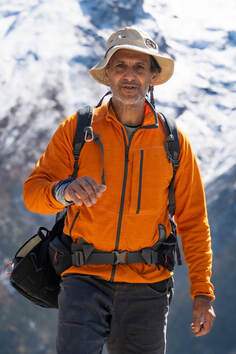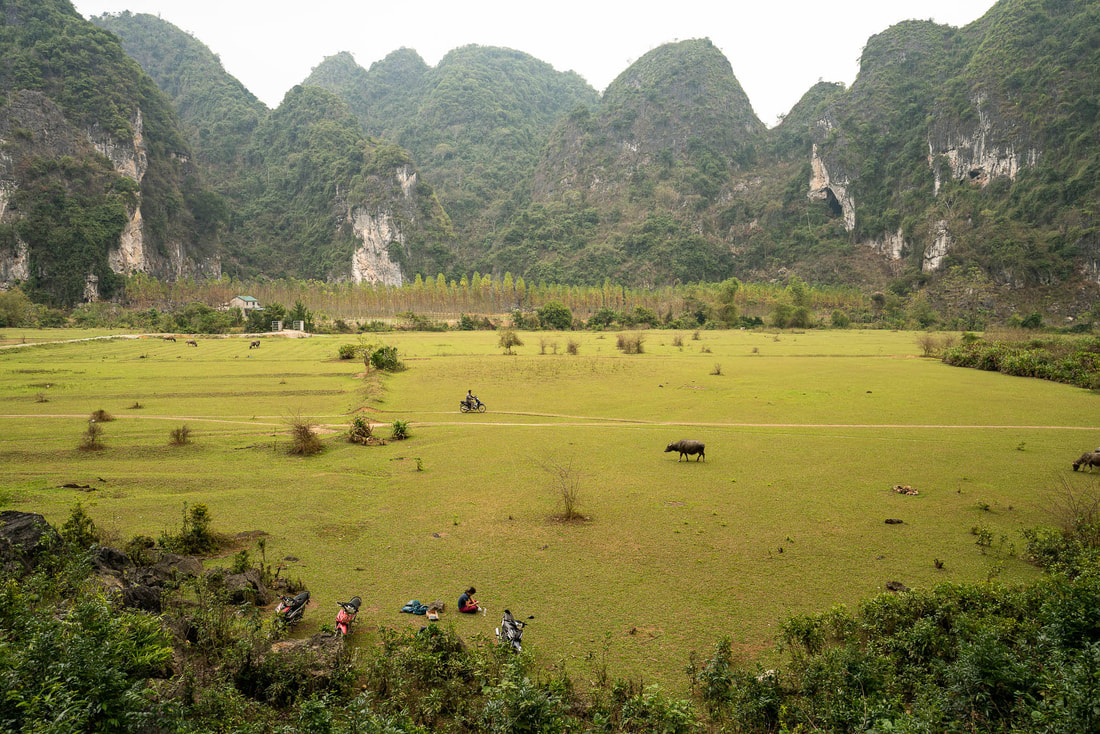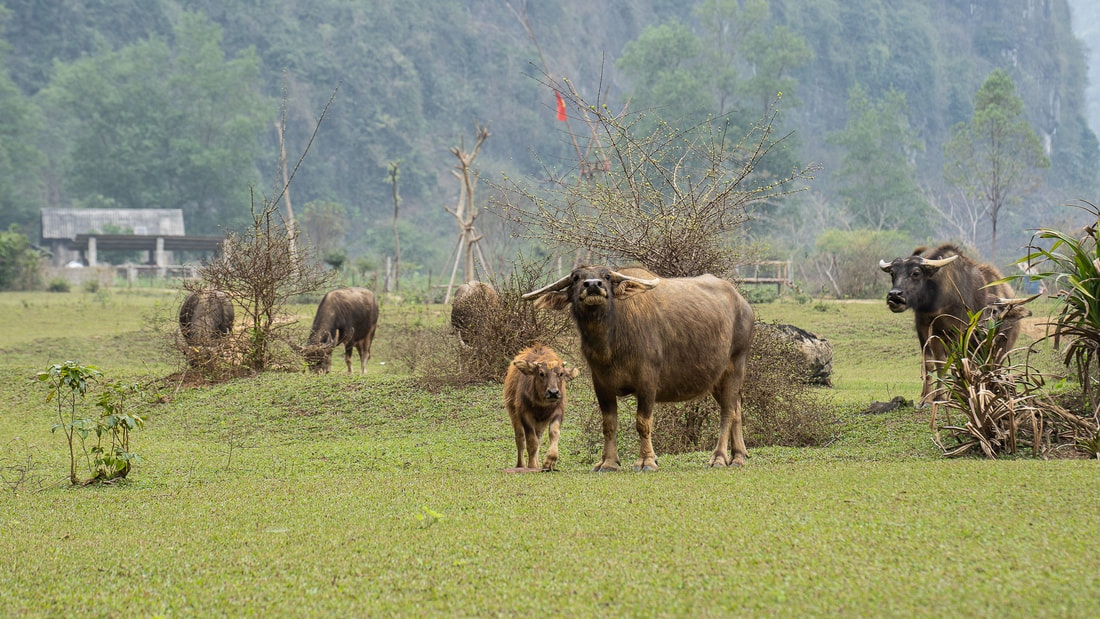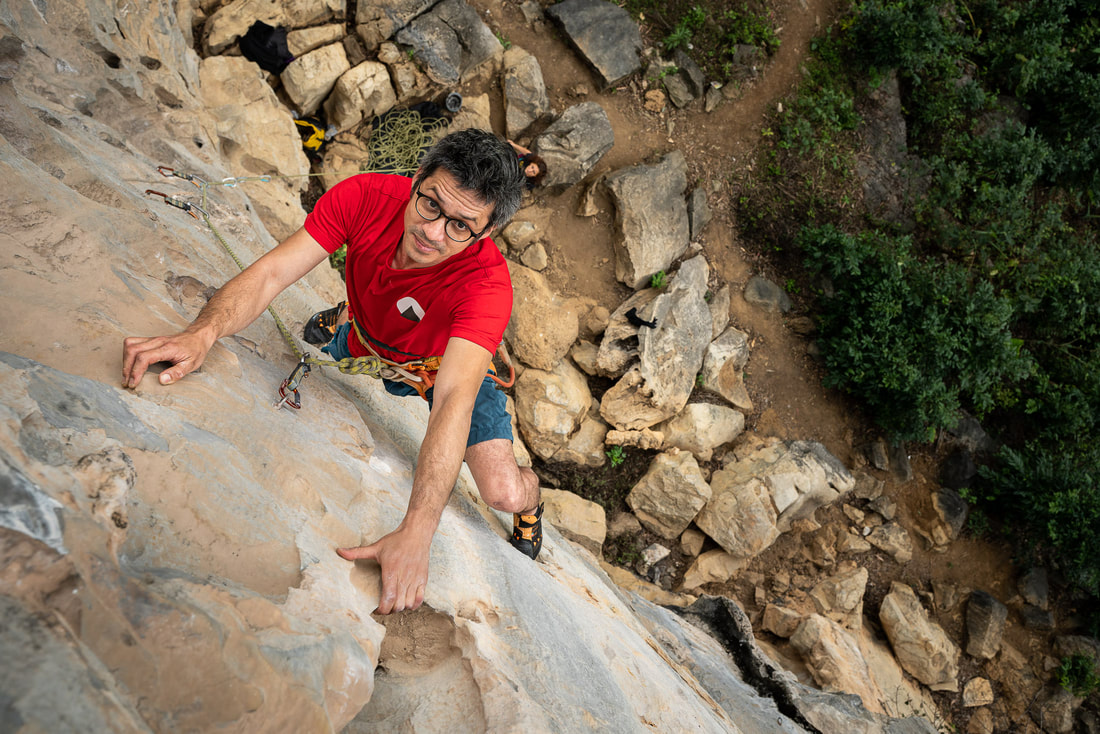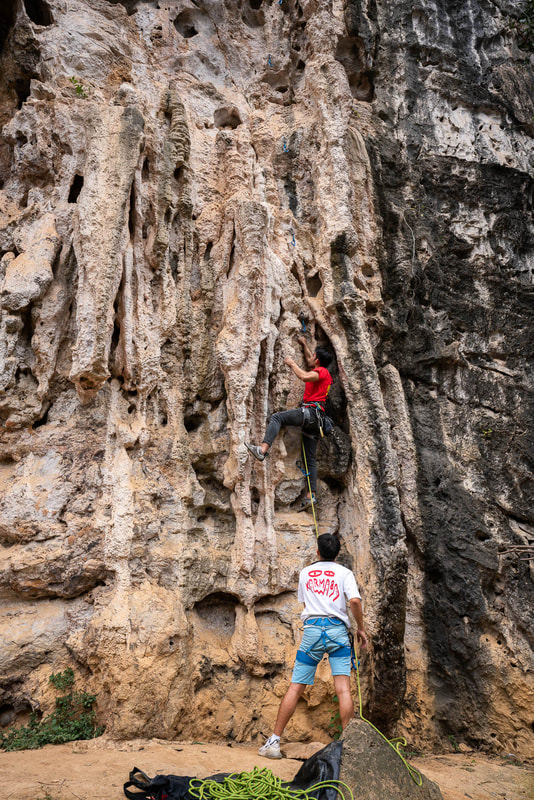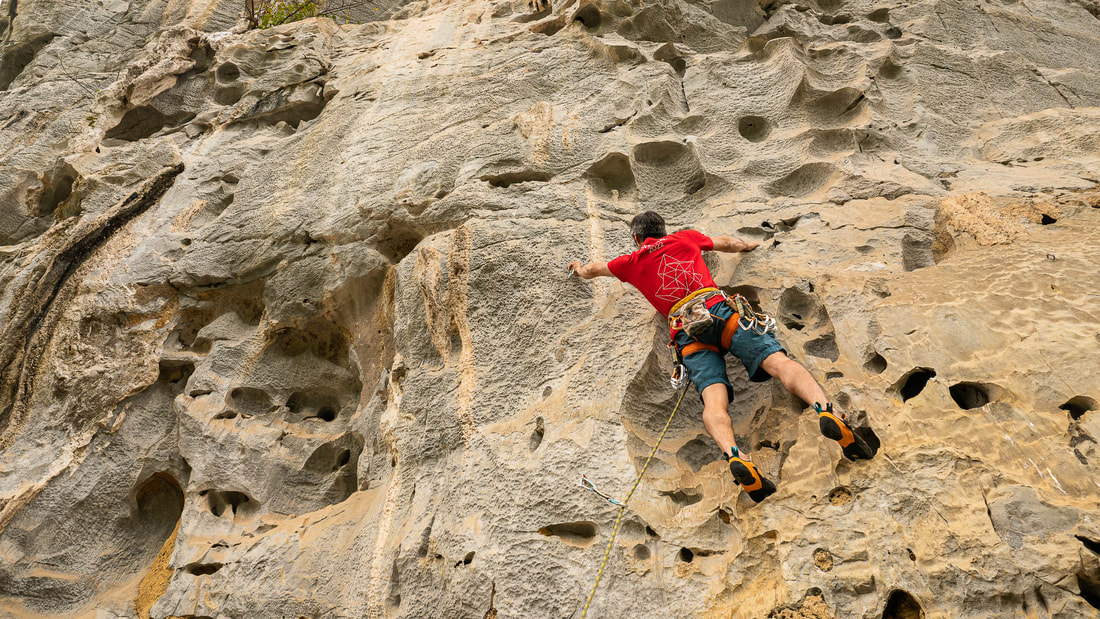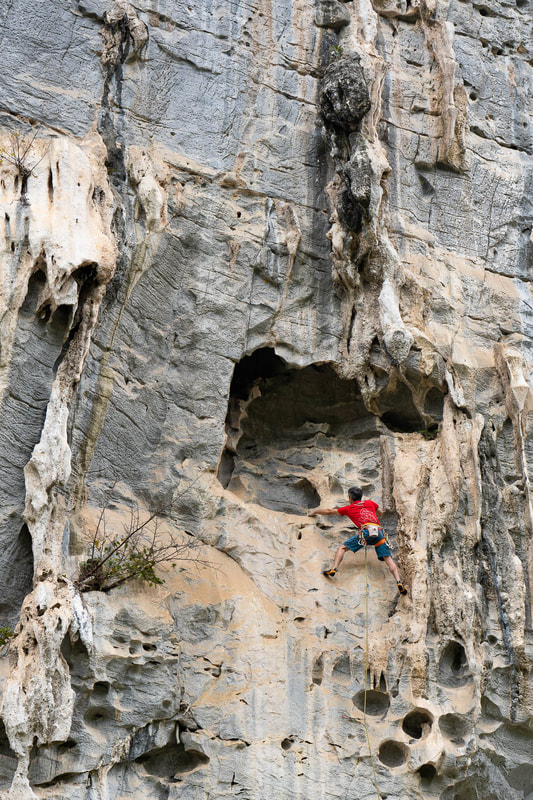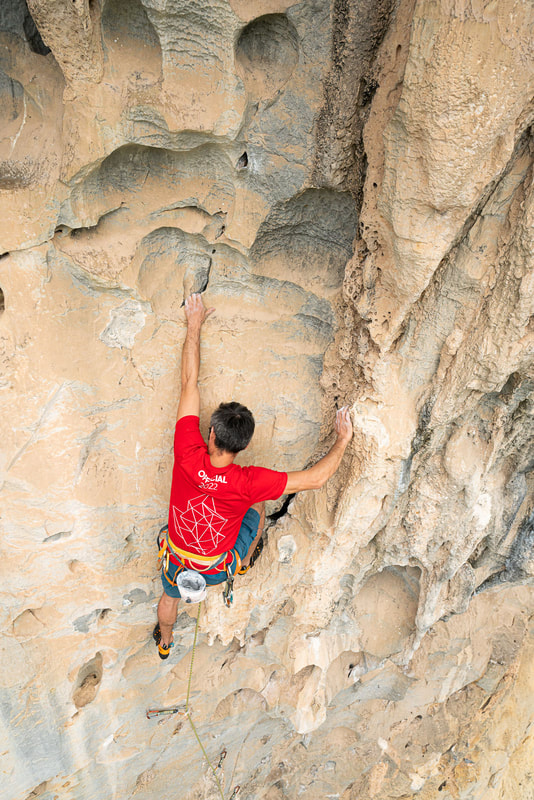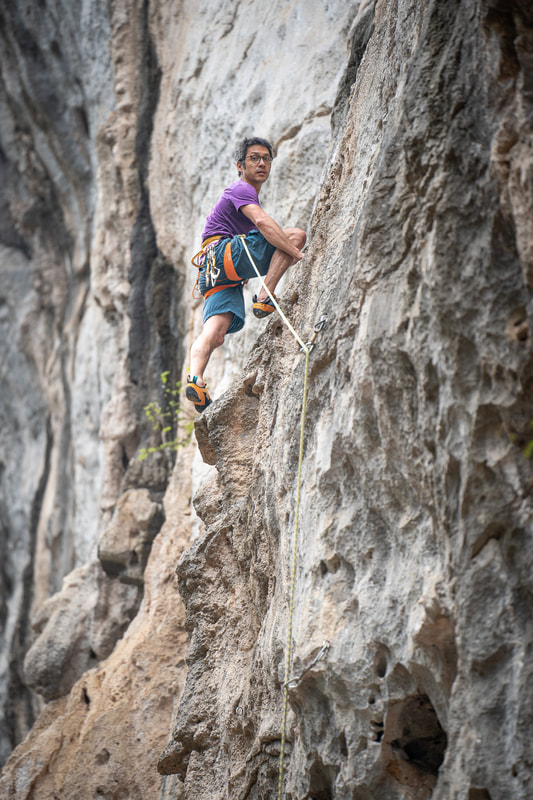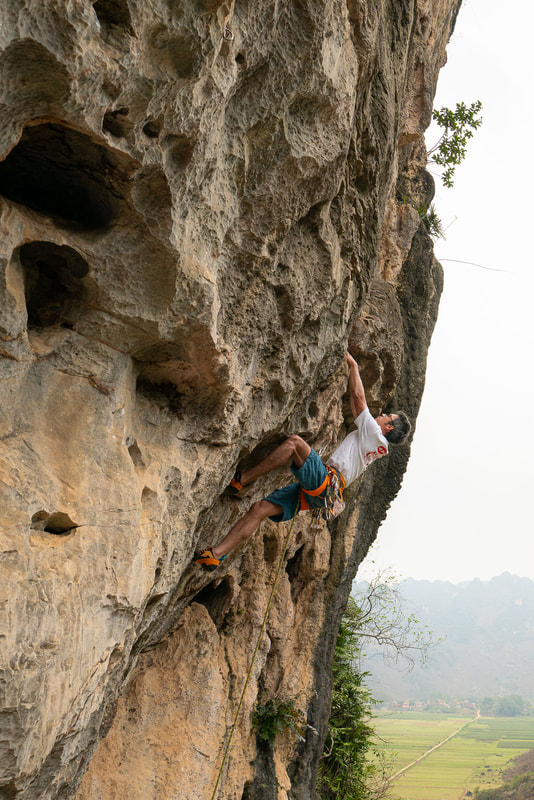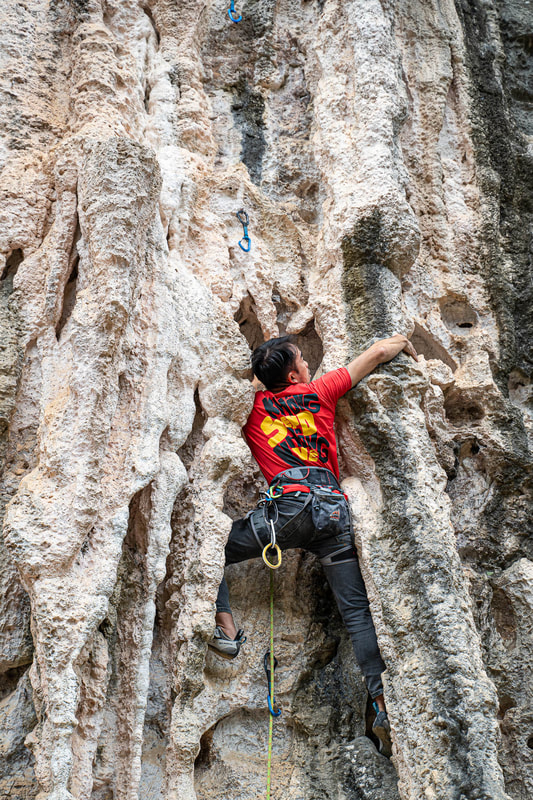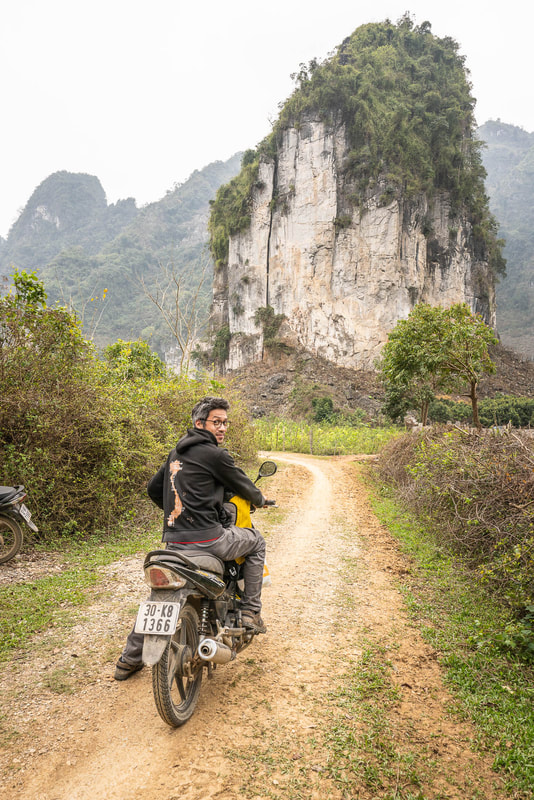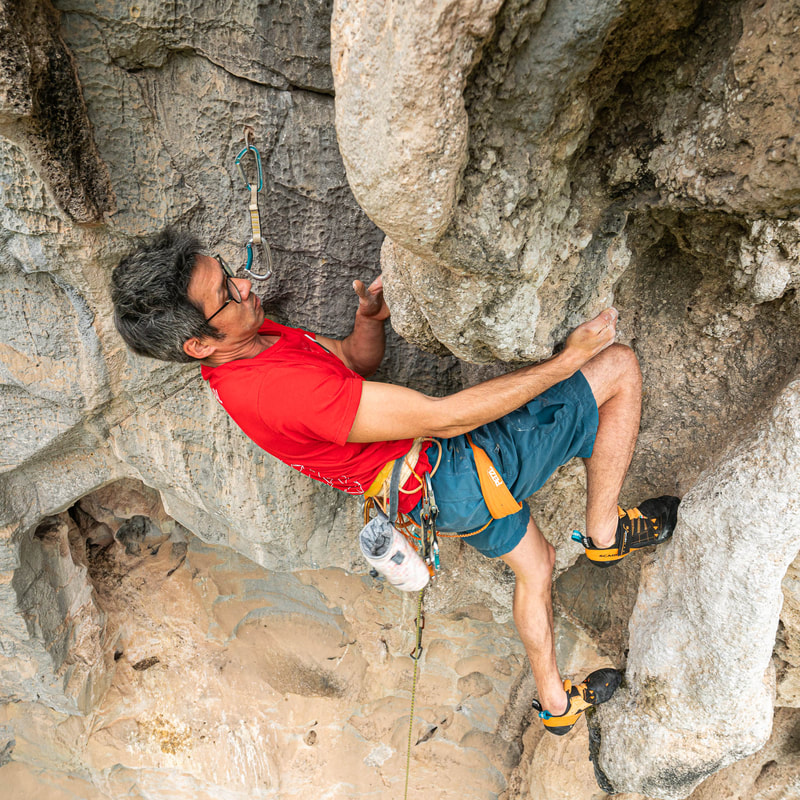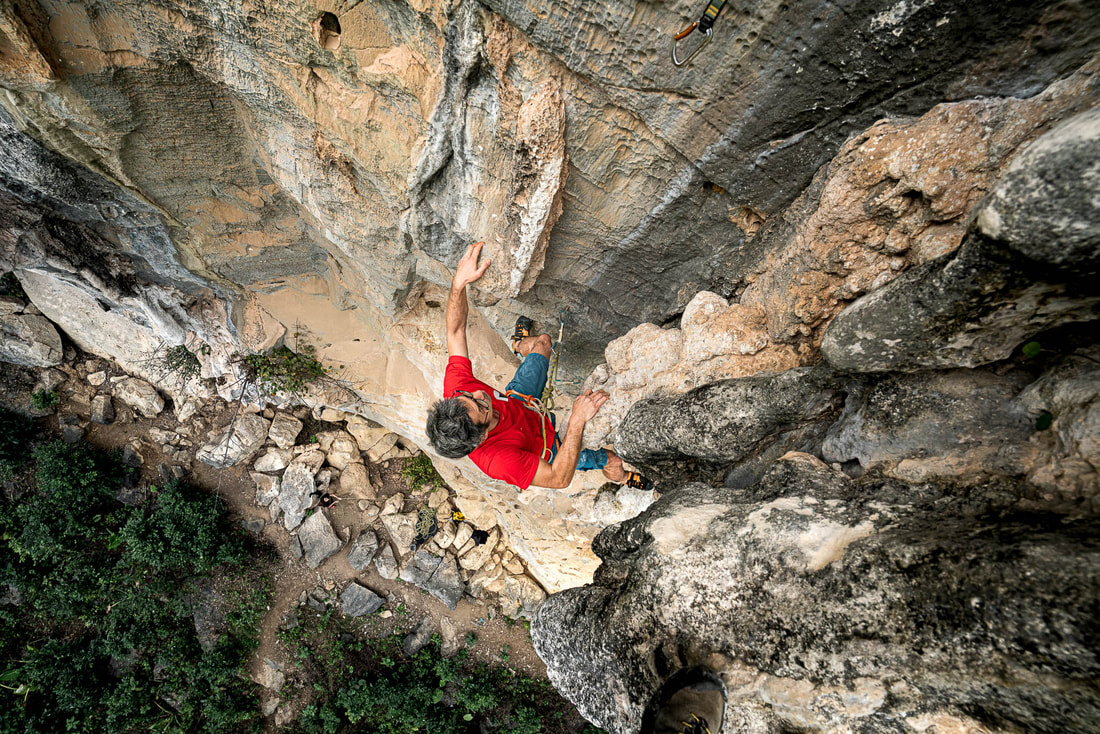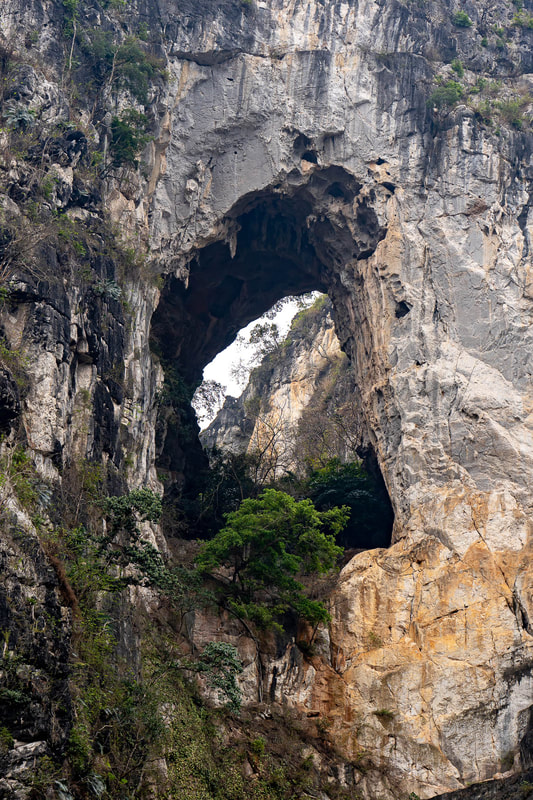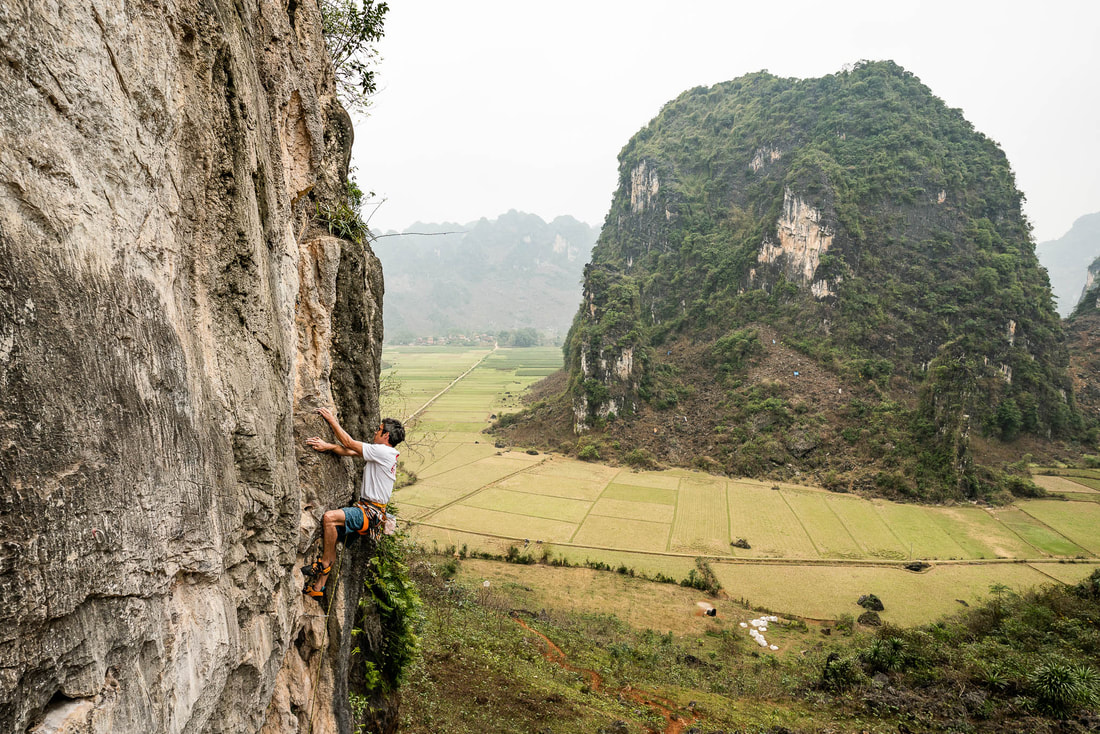ABOVE: Jack Do on "Viet Times" (5b) at Dragon Wall (Photo Credit: Massimo Cappuccio, IG: @massimocappuccio.photo)
|
Climbing photographer Massimo Cappuccio captures images and the story of Jean Verly's discovery and establishment of a new climbing area at the Yen Thinh Valley in Huu Lung, Vietnam. Jean went above and beyond placing bolts in the walls, with a forward-looking vision, Jean assembled a small travel-economy supporting the locals.
|
We left early in the morning, trying to travel during the cool part of the day and leave the city quickly enough to use the same afternoon for climbing. But Hanoi, Vietnam never sleeps - even this early scooters whiz by in all directions and the traffic proceeds slowly between merciless horns.
I have been traveling to the East for many years and never cease to be amazed and enchanted by the colours, the scents, the faces of these gentle peoples and the extraordinary landscapes. Here in Vietnam, especially in Hanoi, there is calm chaos - millions of people wandering in all directions with a apparent calm that is both disarming and fascinating. We are here in Vietnam to discover climbing, and so we head north.
Our contact is Jean Verly, who will guide us amongst the cliffs of the Huu Lung Valley. Jean is of French-Vietnamese origin, born and raised in France but moved to Vietnam many years ago in search of his origins and to give space to his great passion for climbing. Before the 2000s there was no mention of climbing in Vietnam. Then, an international expedition climbed the spires in Halong Bay, taking photos and videos of that spectacular place, jump-starting the attraction for foreign climbers
For years everything was concentrated on the spires of Halong Bay, especially on the island of Cat Ba. Then, little-by-little, a long, and sometimes exhausting, search for other spots to climb began. Jean was certainly one of the pioneer climbers of Vietnam. As he himself told us, for many years he went around, especially in the north of the country, in search of crags. Often, he was not satisfied with what he found. Then, finally, one day he ended up in the Huu Lung district in the Yen Tinh Valley. He quickly realized he had found the ideal place to develop climbing. Now, I leave the floor to him, who will tell us about this incredible place.
I have been traveling to the East for many years and never cease to be amazed and enchanted by the colours, the scents, the faces of these gentle peoples and the extraordinary landscapes. Here in Vietnam, especially in Hanoi, there is calm chaos - millions of people wandering in all directions with a apparent calm that is both disarming and fascinating. We are here in Vietnam to discover climbing, and so we head north.
Our contact is Jean Verly, who will guide us amongst the cliffs of the Huu Lung Valley. Jean is of French-Vietnamese origin, born and raised in France but moved to Vietnam many years ago in search of his origins and to give space to his great passion for climbing. Before the 2000s there was no mention of climbing in Vietnam. Then, an international expedition climbed the spires in Halong Bay, taking photos and videos of that spectacular place, jump-starting the attraction for foreign climbers
For years everything was concentrated on the spires of Halong Bay, especially on the island of Cat Ba. Then, little-by-little, a long, and sometimes exhausting, search for other spots to climb began. Jean was certainly one of the pioneer climbers of Vietnam. As he himself told us, for many years he went around, especially in the north of the country, in search of crags. Often, he was not satisfied with what he found. Then, finally, one day he ended up in the Huu Lung district in the Yen Tinh Valley. He quickly realized he had found the ideal place to develop climbing. Now, I leave the floor to him, who will tell us about this incredible place.
Jean Verly's interview:
What’s the history of VietClimb and how did it come about?
Following my graduation in France in 2005, I traveled for the first time to Vietnam to discover a mysterious half of myself - I was an orphan with a Vietnamese mother.
But I wasn't only seeking to find my history. I was also seeking climbing. I brought some vintage press clippings about Lynn Hill’s Halong Bay expeditions in the 1990’s and Arnaud Petit's climbing in the 2000’s. My climbing gear consumed 70% of my backpack.
After an epic bike trip in the mountains of northern Vietnam, I decided to settle in Hanoi. I got a day job at the French embassy. At a time with no social media, it wasn’t easy to identify climbers in the area, so I created a dedicated website - vietclimb.vn - for climbing resources in Vietnam. This online platform encouraged week-end meetings and, eventually, climbing trips in Ninh Binh and Halong Bay. As we climbers found each other, we bolted routes in the suburbs of Hanoi in Quoc Oai and explored further mountains in Hoa Binh and Ba Be regions.
To stay in shape, I built a 9 square-meter bouldering wall in my rented house. Twice a week, a dozen Hanoi climbers were pulling hard and dreaming about the next weekend outside. In 2010, I decided to scale the project to increase reach and capacity. I opened a small commercial bouldering gym in Tay Ho. In 2012, we put up the first routes in Huu Lung to create a quality, nearby climbing destination to strengthen the synergy between indoor and outdoor climbing. In 2018, the first homestay at Huu Lung was created to tackle the lack of accommodation close to the cliffs in the area. A second homestay location was established in 2020.
But I wasn't only seeking to find my history. I was also seeking climbing. I brought some vintage press clippings about Lynn Hill’s Halong Bay expeditions in the 1990’s and Arnaud Petit's climbing in the 2000’s. My climbing gear consumed 70% of my backpack.
After an epic bike trip in the mountains of northern Vietnam, I decided to settle in Hanoi. I got a day job at the French embassy. At a time with no social media, it wasn’t easy to identify climbers in the area, so I created a dedicated website - vietclimb.vn - for climbing resources in Vietnam. This online platform encouraged week-end meetings and, eventually, climbing trips in Ninh Binh and Halong Bay. As we climbers found each other, we bolted routes in the suburbs of Hanoi in Quoc Oai and explored further mountains in Hoa Binh and Ba Be regions.
To stay in shape, I built a 9 square-meter bouldering wall in my rented house. Twice a week, a dozen Hanoi climbers were pulling hard and dreaming about the next weekend outside. In 2010, I decided to scale the project to increase reach and capacity. I opened a small commercial bouldering gym in Tay Ho. In 2012, we put up the first routes in Huu Lung to create a quality, nearby climbing destination to strengthen the synergy between indoor and outdoor climbing. In 2018, the first homestay at Huu Lung was created to tackle the lack of accommodation close to the cliffs in the area. A second homestay location was established in 2020.
Why have you chosen to develop this particular area?
The decision to develop Huu Lung, and more particularly the village of Yen Thinh, was obvious as it was the kind of crag we had been looking for over the past 6-years. Between 2005 to 2011, we weren’t satisfied with the dozens of areas we’ve explored and assessed. We had four main criteria:
Yen Thinh ticks most of these constraints: This village is accessible from Hanoi in less than 2 hours; It is located in a buffer zone or a front line between limestone quarries which consists of blowing up karst peaks and its ecosystem in the South and a Nature Reserve in the North; It has more than 30 identified cliffs; Local authorities were curious - with a poverty threshold at 27.5% in 2010. Langson province had not benefited yet of the national tourism boom and its related economic growth.
To compare Huu Lung to some other areas: Halong Bay requires 6 hours from “house to crag” and has been significantly spoiled by mass tourism; Cat Ba is located in a National Park; Quoc Oai and Ninh Binh have limited potential with scarce cliffs; And, Hoa Binh’s interesting cliffs were locked by the military at that time. On the local authority front, the province of Langson was the first province in Vietnam to encourage the central government to finally institutionalize the sport of climbing.
- Access: Close enough to the capital to minimize transportation and maximize climbing time - making a day trip possible for Hanoians.
- Location: Different from the existing overloaded tourist destinations and not located in a National Park or a nature reserve, to avoid any wildlife and flora disruption.
- Climbing potential: Possibilities of developing several cliffs within a walking distance (3 kilometers) with different characters in terms of features, steepness, holds, and sun. Clean rock to alleviate too much “gardening” on the cliff and absence of birds to avoid interfering during nesting.
- Local reception: Requirement of neutral or, ideally, enthusiastic reception from local authorities for a new sport (climbing was unregulated in Vietnam until September 2020.)
Yen Thinh ticks most of these constraints: This village is accessible from Hanoi in less than 2 hours; It is located in a buffer zone or a front line between limestone quarries which consists of blowing up karst peaks and its ecosystem in the South and a Nature Reserve in the North; It has more than 30 identified cliffs; Local authorities were curious - with a poverty threshold at 27.5% in 2010. Langson province had not benefited yet of the national tourism boom and its related economic growth.
To compare Huu Lung to some other areas: Halong Bay requires 6 hours from “house to crag” and has been significantly spoiled by mass tourism; Cat Ba is located in a National Park; Quoc Oai and Ninh Binh have limited potential with scarce cliffs; And, Hoa Binh’s interesting cliffs were locked by the military at that time. On the local authority front, the province of Langson was the first province in Vietnam to encourage the central government to finally institutionalize the sport of climbing.
What is your ethos regarding the environment and the impact of climbers?
|
I believe we have been shaped since at least the XVIIth century by the classical Cartesian rationalist idea and Promethean posture that humans could "master and should possess nature." This approach has been scaled with The Age of Enlightenment, when sciences expanded and improved risk anticipation, agriculture production, and the domestication of nature.
During the Industrial Revolution, with its mechanization and process optimization, the environment became a resource to exploit and commercialize with a goal of spreading comfort and strengthening economic development. Since then, commodification and globalization have increased environmental pressure. These paradigms haven’t shifted, even though signals have been triggered for more than 50 years that they need to shift. The Meadow's report proposed to tackle this situation in 1972, then came the Paris Agreement in 2015 to mitigate environmental consequences of our actions. Nowadays it’s all about alleviation and resilience, which sounds to me like a semantic dodge. We rely on - or are turning to - current technology as solutions, or "pollution offsets" to allow us to keep commodifying the environment. This is to the detriment of common-pool resource management and behavioral shifts. Environmental deterioration and depletion are a global reality and a shared responsibility impacting us all. We have seen this with the recent floods in Europe, Africa and Asia, or the fires in the U.S. and Russia. However, we should not surrender or emphasize only the downsides. We should believe that we can have an impact individually, within our local community at the grassroot level, through initiatives to raise awareness about consumption choice or lifestyle adoption. |
Although tourism can greatly impact the environment, if done in a way that supports the locals and has protections, it can help the locals while still providing a unique experience for visitors and minimizing environmental impact. That is what we are trying to do at Yen Thinh.
How do you involve the local community in your work?
At the village of Yen Thinh, the local community is our main partner. The process is quite simple:
- We identify local families who are located near the crags and whose homes require renovation and the addition of basic sanitation or water facilities.
- We invest in the construction, renovation, and the basics such as fridge, bedding, and food and beverage equipment. We bought kitchenware, refrigerators, coffee machines, etc., then looked into what kind of menu would be good for both locals and foreigners.
- Almost all the required work is done by villagers (masonry and carpentry), under the lead of one of our Project Managers. For mechanical and electical work, we had to bring in trades-people from Hanoi. All equipment is sourced locally.
- We train families for hosting, cooking, and how to run their own business. We also ask them to officially register their activities.
- We do the branding, marketing and sales, bringing pride to the village to be identified as a significant climbing destination. This also connects the local authorities to the central government.
- For the crags, we identify who owns the land at the bottom of the cliffs and develop agreements to have climbers pass through their lands.
- Financially, we invest 100% of the initial required investment, then equally split the revenues. Until Covid, the estimated monthly extra household income from this diversification was doubled.
The diversity of climbs at the Yen Thinh Valley in the Huu Lung district in Vietnam Click on the photos above to enlarge. (Photo Credit: Massimo Cappuccio, IG: @massimocappuccio.photo)
|
Are these guided or coordinated trips?
Not really coordinated trips, many autonomous climbers go by their own, but they book our homestays.
Behind the development of a large climbing area like this (14 sectors for over 180 routes), there is always a great deal of physical work, economic and time commitment, sometimes borne by just a few people. Tell us how you developed these sectors and who supported you in all this work.
From the beginning, the idea was to create synergies and bridges between indoor and outdoor climbing, the urban and the rural areas, sport climbing and bouldering. We managed to reallocate some funds from the boulder gym to get bolting gear and bolts. I got Benjamin Bolnot, the first professional route-setter/guide who was hired at the gym in 2014, involved in the development of several crags.
Benjamin brought along his friends Jonas Bertoux, Kevin Resve and Florent Vizzier, who since then came back twice. Francis Haden and Giacomo Crivelli were also a great help. In recent years, Thibaud Vantalon, a researcher based in Hanoi, has been a leading force in the development of the latest crags. |
Do you see the natural environment changing at the crag, due to the impact of climbers or other environmental impacts?
Huu Lung is mostly a local and regional destination. The reasonable visitation levels to Yen Thinh mitigate the impact on the flora and fauna of the cliffs. Polished holds and chalk marks are rare. A strong “leave no trace” approach has been adopted.
Many environmental changes - not related to climbing - have been seen these last 10 years. Cultures are spreading and getting higher and higher in the mountains encroaching on the jungle. The mining industry is increasing and more mountains are selected to be blown, crushed, and ground. Though these changes might have a positive impact on agriculture, production, or infrastructure/housing construction, a balance needs to be found to avoid soil erosion and landscape destruction in the longer term.
If climbing becomes enough of an economic draw, communities may not feel the pressure to give in to some of these bigger environmental impacts. Climbers do have an environmental impact, but it is far less than these other things, and climbers can do things to help minimize the impact we cause. If done right, climbing can be a form of ecotourism.
Many environmental changes - not related to climbing - have been seen these last 10 years. Cultures are spreading and getting higher and higher in the mountains encroaching on the jungle. The mining industry is increasing and more mountains are selected to be blown, crushed, and ground. Though these changes might have a positive impact on agriculture, production, or infrastructure/housing construction, a balance needs to be found to avoid soil erosion and landscape destruction in the longer term.
If climbing becomes enough of an economic draw, communities may not feel the pressure to give in to some of these bigger environmental impacts. Climbers do have an environmental impact, but it is far less than these other things, and climbers can do things to help minimize the impact we cause. If done right, climbing can be a form of ecotourism.
|
As the discoverer and developer of the Huu Lung area, what would you recommend to anyone who comes to climb here? (For a short stay of a few days, best time to come and climb here, in the rainy season?)
Most of the crags are sheltered from light rain and are in the shade, the best season runs from October to April. However, local climbers come all year-round. It could be extremely hot, but it’s a good training inspired by hot yoga!
Though it’s all limestone, every crag has a different character and offers different styles of climbing. Many routes follow tufa lines in a 3-dimensional fashion typical of the South-East Asian rock, especially at Head Wall, Passe-Muraille, and Thanh Giong. Squirrel Wall and WoofStuck have steeper profiles on compact rock, with excellent pockets and tricky holes. There are also some vertical and technical lines such as l’Ile Noire and Dead End. It’s difficult to recommend only a couple of crags. It depends on your taste. The Arch remains a geological wonder which naturally woos climbers. |
Huu Lung - General Information
Yen Thinh valley is located in Huu Lung District in northern Vietnam, about 100 kilometers (about 60 miles) northeast of Hanoi. Hanoi is the headquarters of VietClimb, a large bouldering gym where organized trips to Huu Lung depart. You can contact Jean who can organize your climbing days in Huu Lung, including staying at a climber's homestay, renting scooters, arranging courses for beginners, or equipment rental.
It is also possible to go to Huu Lung independently and manage all the logistics on your own, but it will require Vietnamese-language skills and a lot of time.
Access: Huu Lung is a couple of hours by car from Hanoi, the capital of Vietnam, which is easily
accessible by plane from anywhere in the world. Public transport does not have a direct route between Hanoi and Huu Lung, so the journey with can take a whole day. The best solution is to go with a private taxi, especially if you are traveling with several people and can split the cost. The taxi will take you directly to the homestay.
From there, to reach the various cliffs it is necessary to have another vehicle. The most convenient and fun way is to rent a moped. This allows you to move freely and explore the whole area.
Many crags are a few kilometers from each other, but to reach the most distant ones you have to travel up to 15 kilometers from the base camp of Mao's Homestay. Access to many crags is through "private land." In reality the land is collectively owned by the People and administered by central and local government on their behalf. Climbers are asked to pay an access fee (usually $1 USD) to the farmers who have the Land Use Rights.
Accommodation: It is possible to find some homestays located in the area. Mao's Homestay and Duc’s Bungalows are by far the most popular places to stay and the closest to the crags. These are funded and managed by VietClimb in a joint-venture with two local families. Here it is possible to find all the info on the crags, rent mopeds, and above all, taste the delicacies of the local cuisine.
Climbing: The climbing here is on limestone. There are both technical vertical walls and overhanging walls full of tufas and stalactites, even of large dimensions. All sectors are well equipped with stainless steel bolts, and the routes are often very long, often exceeding 30 metres (100 feet). An 80-metre rope and a set of at least 16 quickdraws are advisable. Many walls are clean, but it is always advisable to use a helmet. Many crags face north, allowing you to climb in the shade. However, the best season goes from October to April, when temperatures are more acceptable.
It is also possible to go to Huu Lung independently and manage all the logistics on your own, but it will require Vietnamese-language skills and a lot of time.
Access: Huu Lung is a couple of hours by car from Hanoi, the capital of Vietnam, which is easily
accessible by plane from anywhere in the world. Public transport does not have a direct route between Hanoi and Huu Lung, so the journey with can take a whole day. The best solution is to go with a private taxi, especially if you are traveling with several people and can split the cost. The taxi will take you directly to the homestay.
From there, to reach the various cliffs it is necessary to have another vehicle. The most convenient and fun way is to rent a moped. This allows you to move freely and explore the whole area.
Many crags are a few kilometers from each other, but to reach the most distant ones you have to travel up to 15 kilometers from the base camp of Mao's Homestay. Access to many crags is through "private land." In reality the land is collectively owned by the People and administered by central and local government on their behalf. Climbers are asked to pay an access fee (usually $1 USD) to the farmers who have the Land Use Rights.
Accommodation: It is possible to find some homestays located in the area. Mao's Homestay and Duc’s Bungalows are by far the most popular places to stay and the closest to the crags. These are funded and managed by VietClimb in a joint-venture with two local families. Here it is possible to find all the info on the crags, rent mopeds, and above all, taste the delicacies of the local cuisine.
Climbing: The climbing here is on limestone. There are both technical vertical walls and overhanging walls full of tufas and stalactites, even of large dimensions. All sectors are well equipped with stainless steel bolts, and the routes are often very long, often exceeding 30 metres (100 feet). An 80-metre rope and a set of at least 16 quickdraws are advisable. Many walls are clean, but it is always advisable to use a helmet. Many crags face north, allowing you to climb in the shade. However, the best season goes from October to April, when temperatures are more acceptable.

